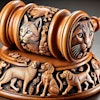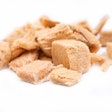This study evaluated the effect of two rendering processes applied to meat and bone meal (MBM) production, associated or not with extrusion, by measuring diet apparent total tract digestibility of dogs and cats and true digestibility of amino acids (AA) by cecectomized roosters. Four diets were evaluated: conventional and extruded MBM; high temperature and pressure (HPT; 135C, 3 bar, 20 minutes) and extruded MBM; conventional non-extruded MBM; and HPT non-extruded MBM.
The evaluated MBM had high ash content. The HPT process of MBM increased the digestibility of crude protein of the diets by cats and the true digestibility of several AA by cecectomized roosters. The extrusion process did not modify the apparent total tract nutrient digestibility of MBM by dogs and their amino acid digestibility by roosters, but increased the digestibility of the dietary protein by cats. Dogs fed HPT MBM presented a higher urea post-prandial response, suggesting reductions in bioavailability and protein synthesis from absorbed AA.
Source : L.D. de-Oliveira et al., 2011. Digestibility for dogs and cats of meat and bone meal processed at two different temperature and pressure levels. JAPAN online September 2011. doi: 10.1111/j.1439-0396.2011.01232.x

















